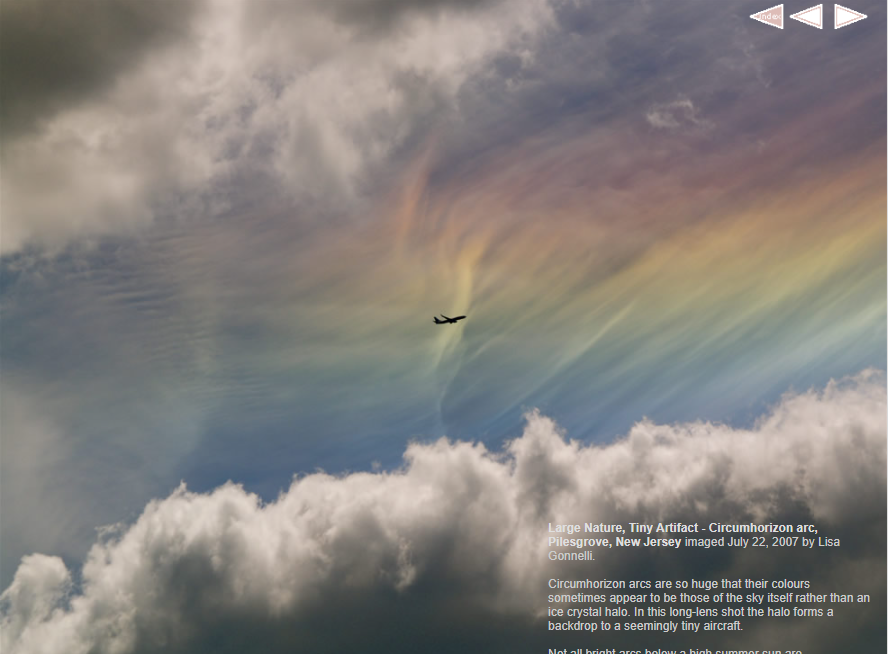Circumhorizon arc - Pilesgrove, New Jersey
Have you ever looked up at the sky and been captivated by the beauty of its colors? Sometimes, nature surprises us with breathtaking optical displays that seem almost otherworldly. One such phenomenon is the Circumhorizon Arc, a celestial spectacle that graced the skies of Pilesgrove, New Jersey on July 22, 2007. In this article, we will delve into the details of this awe-inspiring event and explore the science behind it.
The Circumhorizon Arc is a massive atmospheric optical phenomenon that can be so vast that its colors blend seamlessly with the sky itself, creating a surreal visual experience. It is often mistaken for a halo formed by ice crystals in the atmosphere. However, in the case of the photograph captured by Lisa Gonnelli, the arc serves as a magnificent backdrop for a seemingly minuscule aircraft. The stark contrast between the size of the arc and the tiny artifact emphasizes the grandeur of this natural wonder.
Not all bright arcs observed beneath a high summer sun are circumhorizon arcs. They could also be infralateral arcs or, less commonly, parts of a 46-degree halo. Distinguishing between these possibilities requires careful observation and measurement. To identify this particular arc in Pilesgrove, factors such as the presence of other halos in the sky and local sightings were taken into account. While it is highly likely that it is a circumhorizon arc, we cannot completely rule out the possibility of it being an infralateral arc.
The sheer scale and complexity of atmospheric optics make it a fascinating subject to study. These phenomena occur due to the interaction of sunlight with various particles and crystals suspended in the atmosphere. In the case of circumhorizon arcs, their formation is attributed to ice crystals present in cirrus clouds. These crystals act as prisms, refracting sunlight and separating it into its constituent colors. As a result, the vibrant hues of the arc are revealed, creating a mesmerizing display.
To better understand the intricacies of circumhorizon arcs, it is helpful to explore the science behind their formation. The necessary conditions for their occurrence include the presence of cirrus clouds at a high altitude, a specific solar elevation angle, and the orientation of the ice crystals within the clouds. When sunlight enters these clouds at a particular angle, it undergoes multiple internal reflections and refractions within the ice crystals. This intricate process causes the separation of colors and gives rise to the distinct arc shape.
The size and shape of a circumhorizon arc depend on several factors, including the altitude of the cirrus clouds and the observer's position relative to the sun. Typically, these arcs are characterized by their immense width and curvature, spanning large portions of the sky. They are often observed parallel to the horizon, hence the name "circumhorizon" arc. The vivid colors exhibited by these arcs are a result of the dispersion of light within the ice crystals, with red being closest to the sun and blue appearing on the outer edge.
Witnessing a circumhorizon arc is an extraordinary experience that reminds us of the wondrous phenomena occurring in our atmosphere. It serves as a testament to the beauty and complexity of nature's creations. While occurrences of circumhorizon arcs may be relatively rare, they can be found in various locations around the world. Pilesgrove, New Jersey was fortunate enough to witness this mesmerizing event, leaving an indelible memory in the minds of those who had the opportunity to observe it.
In conclusion, the Circumhorizon Arc that adorned the skies of Pilesgrove, New Jersey on July 22, 2007, was a sight to behold. Its immense size and vivid colors made it a captivating spectacle. While it can be challenging to differentiate circumhorizon arcs from other atmospheric optical phenomena, careful observation and analysis can provide valuable insights. The science behind these arcs reveals the fascinating interplay between sunlight and ice crystals in the atmosphere. So, the next time you find yourself gazing at the sky, remember that there may be hidden wonders waiting to be discovered, just like the awe-inspiring Circumhorizon Arc.

Large Nature, Tiny Artifact - Circumhorizon arc, Pilesgrove, New Jersey imaged July 22, 2007 by Lisa Gonnelli.
Circumhorizon arcs are so huge that their colours sometimes appear to be those of the sky itself rather than an ice crystal halo. In this long-lens shot the halo forms a backdrop to a seemingly tiny aircraft.
Not all bright arcs below a high summer sun are circumhorizons. They could be infralateral arcs or - much less likely - parts of a 46 degree halo. It can take the sighting of an almost complete arc and careful measurement to distinguish between the possibilities. This one, taking account of other halos in the sky and other local sightings, is most probably a circumhorizon but an infralateral arc cannot be totally ruled out.
Image ©Lisa Gonnelli, shown with permission.
Note: this article has been automatically converted from the old site and may not appear as intended. You can find the original article here.
Reference Atmospheric Optics
If you use any of the definitions, information, or data presented on Atmospheric Optics, please copy the link or reference below to properly credit us as the reference source. Thank you!
-
<a href="https://atoptics.co.uk/blog/circumhorizon-arc-pilesgrove-new-jersey/">Circumhorizon arc - Pilesgrove, New Jersey</a>
-
"Circumhorizon arc - Pilesgrove, New Jersey". Atmospheric Optics. Accessed on November 26, 2024. https://atoptics.co.uk/blog/circumhorizon-arc-pilesgrove-new-jersey/.
-
"Circumhorizon arc - Pilesgrove, New Jersey". Atmospheric Optics, https://atoptics.co.uk/blog/circumhorizon-arc-pilesgrove-new-jersey/. Accessed 26 November, 2024
-
Circumhorizon arc - Pilesgrove, New Jersey. Atmospheric Optics. Retrieved from https://atoptics.co.uk/blog/circumhorizon-arc-pilesgrove-new-jersey/.